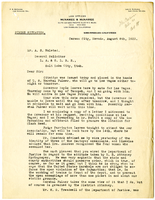Search the Special Collections and Archives Portal
Search Results

Letter from J. K. W. Bracken to J. Ross Clark, September 8, 1903
Date
1903-09-08
Archival Collection
Description
Letter from J. K. W. Bracken to J. Ross Clark, September 8, 1903
Text

Letter from J. T. McWilliams letter to J. Ross Clark, November 24, 1902
Date
1902-11-24
Archival Collection
Description
Letter from J. T. McWilliams letter to J. Ross Clark, November 24, 1902
Text

Letter from W. H. Bancroft to J. Ross Clark, June 16, 1904
Date
1904-06-16
Archival Collection
Description
Letter from W. H. Bancroft to J. Ross Clark, June 16, 1904
Text

Letter from William McDermott letter to C. O. Whittemore, November 7, 1902
Date
1902-11-07
Archival Collection
Description
Letter from William McDermott letter to C. O. Whittemore, November 7, 1902
Text

Letter from William McDermott letter to J. Ross Clark, April 9 1903
Date
1903-04-09
Archival Collection
Description
Letter from William McDermott letter to J. Ross Clark, April 9 1903
Text

Letter from William McDermott letter to J. Ross Clark, April 18, 1903
Date
1903-04-18
Archival Collection
Description
Letter from William McDermott letter to J. Ross Clark, April 18, 1903
Text

Letter from McDermott to Clark, December 8, 1902
Date
1902-12-08
Archival Collection
Description
Reports changes on the bill of sale of the Stewart Ranch
Text

Letter from William McDermott to Clark, December 11, 1902
Date
1902-12-11
Archival Collection
Description
Reports status of the ranch and recommends changes and repairs. Includes a list of necessities.
Text

Prospectus, Original Gilbert Mines Company, 1900-1925
Date
1900 to 1925
Archival Collection
Description
Prospectus, Original Gilbert Mines Company, 1900-1925
Text

Letter from Frank R. McNamee to A. S. Halsted, August 8, 1922
Date
1922-08-08
Archival Collection
Description
Caption: STRIKE SITUATION
Text
Pagination
Refine my results
Content Type
Creator or Contributor
Subject
Archival Collection
Digital Project
Resource Type
Year
Material Type
Place
Language
